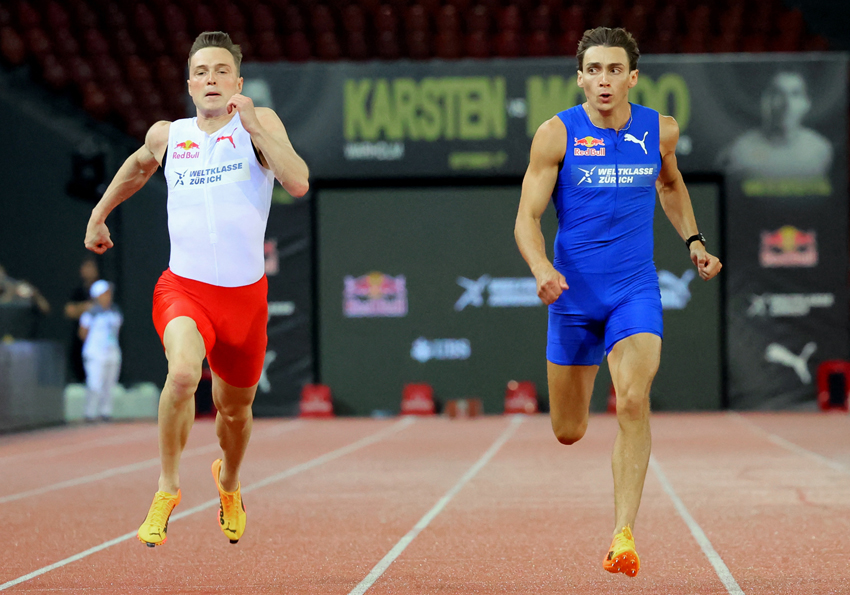Calories and performance: the perils of weight management

All things being equal (eg power, strength, maximum oxygen uptake etc), a lower body mass will lead to better endurance performance. This is particularly true in weight-bearing sports such as running where the body has to be repeatedly lifted against gravity with each footstrike throughout the race distance. This reality is reflected in many athletes’ attempts to maintain a low(er) body weight through restricted diets and larger training volumes. And to a large extent, this approach can be effective as many have experienced.
Health implications
Of course, the potential problem with this line of thought is that all things are never equal. Reducing energy intake and increasing training volumes can reduce body mass and improve performance up to a point. However, beyond that point, it has become more and more apparent that health is compromised, especially when this approach is taken to the extreme or simply carried on for an extended period of time.
Unfortunately, health concerns are not always sufficient for athletes to adjust their approach. But there is emerging evidence that not only are long-term energy deficits potentially problematic from a health perspective, but they can also lead to losses of performance as well. While compromised health might not get athletes’ attention, compromised performance almost certainly will!
To better understand the impact of energy status on performance, research needs to determine the relationship between energy status over the course of a competitive season. Currently, there isn’t a lot of data on the link between performance energy status as there have been few studies that have directly examined it. Fortunately however, a group of American researchers have risen to the challenge to address this issue via a study that has tracked distance runners over the course of season, comparing their energy statuses and performances(1).
The research
Unlike most previous studies that have investigated energy status in athletes, this was a prospective study, which means is that the subjects were measured prior to beginning of the study and then measured again afterwards. Most studies are retrospective, in that they only take measurements at the end of the study. While retrospective studies are useful for generating ideas and finding correlations, they are much less robust in terms of investigating what causes a specific outcome to occur.
This study consisted of 38 premenopausal females who were competitive long-distance runners. All the subjects were currently NCAA Division I athletes or elite competitive club runners. They were assessed prior to the start of a 10-12 week season and again at the conclusion of the season. Twenty one of the runners completed both the pre-testing and post-testing. The subjects performed their normal training and competition throughout the season.
The goal of the study was to better understand the relationships between various measures of energy balance and the athletes’ competitive performances. A competitive time trial was performed before and after the season as the primary measure of performance, in which the subjects raced against their teammates on a standardized 5-kilometer cross country course. This was regarded as a good test since the athletes were highly motivated, and this test was seen as a strong indicator of their fitness and readiness.
What was measured
A variety of measures were used to assess energy status. First, resting metabolic rate was determined. This measure indicates how many calories you burn while at rest. When this number is significantly lower than the predicted value based on age, sex, and size, it can indicate an energy deficiency over time (caused by a sub-optimum calorie intake). The cutoff for determining a ‘suppressed metabolism’ is when the resting metabolic rate is less than 92% of predicted resting metabolic rate. Accordingly, the athletes were then categorized as either metabolically suppressed or non-metabolically suppressed.
To gain a deeper understanding of the subjects’ energy status, exercise energy expenditures and energy intakes were calculated. Exercise energy expenditure can be calculated from the volume and intensity of training, which was recorded in training logs. Meanwhile, diet logs were used to measure energy intake on both weekdays and weekends. This information was used to calculate energy availability. Energy availability is calculated as the amount of energy that is left over from energy intake after exercise energy expenditure is removed. Having low energy availability is associated with multiple negative health outcomes.
Further testing was performed to determine which factors could potentially explain any relationships between energy balance and performance. Measures of body composition were taken, such as fat mass, lean mass, and body fat percentage. VO2max, a measure of aerobic capacity, was tested to gain an understanding of the physiological capacities of the subjects. Blood sampling was performed to test for hormone status, specifically total triiodothyronine (TT3), a marker of thyroid and energy status.
You need to be logged in to continue reading.
Please register for limited access or take a 30-day risk-free trial of Sports Performance Bulletin to experience the full benefits of a subscription. TAKE A RISK-FREE TRIAL
TAKE A RISK-FREE TRIAL
Newsletter Sign Up
Testimonials
Dr. Alexandra Fandetti-Robin, Back & Body Chiropractic
Elspeth Cowell MSCh DpodM SRCh HCPC reg
William Hunter, Nuffield Health
Newsletter Sign Up
Coaches Testimonials
Dr. Alexandra Fandetti-Robin, Back & Body Chiropractic
Elspeth Cowell MSCh DpodM SRCh HCPC reg
William Hunter, Nuffield Health
Keep up with latest sports science research and apply it to maximize performance
Today you have the chance to join a group of athletes, and sports coaches/trainers who all have something special in common...
They use the latest research to improve performance for themselves and their clients - both athletes and sports teams - with help from global specialists in the fields of sports science, sports medicine and sports psychology.
They do this by reading Sports Performance Bulletin, an easy-to-digest but serious-minded journal dedicated to high performance sports. SPB offers a wealth of information and insight into the latest research, in an easily-accessible and understood format, along with a wealth of practical recommendations.
*includes 3 coaching manuals
Get Inspired
All the latest techniques and approaches
Sports Performance Bulletin helps dedicated endurance athletes improve their performance. Sense-checking the latest sports science research, and sourcing evidence and case studies to support findings, Sports Performance Bulletin turns proven insights into easily digestible practical advice. Supporting athletes, coaches and professionals who wish to ensure their guidance and programmes are kept right up to date and based on credible science.








